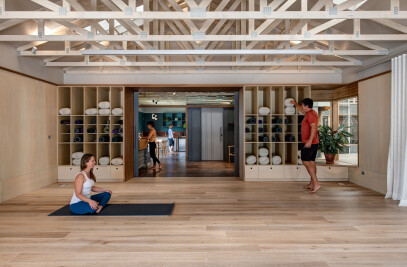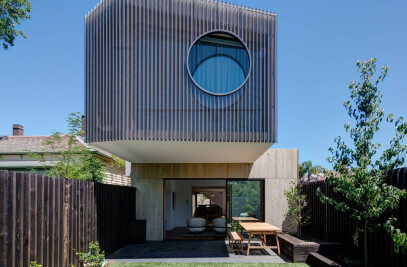Designed as the temporary heart of the ANU campus for 18 months during the redevelopment of the new Union Court development, the ANU Pop-Up Reunion Village was designed by OCULUS and Craig Tan Architects in association. Conceived as a connective day and night environment for the students, the village accommodates the temporary relocation of ANU’s retail core, including student services, student organisations, common spaces, and food and beverage.
Located adjacent to the tree lined University Avenue to attract an audience from the University and Canberra city, the village consists of 2400sqm of enclosed space and 1600sqm of decking space, and is envisioned as a bridge between ANU and the city.
The village is composed around four interrelated sections centred at the confluence of a primary North-South path, and University Avenue. For economy, these comprise a mixture of new-build, fitout, and even site shed accommodations.
The first area is the Commons zone, which accommodates a large enclosed multi-purpose space, with associated tenancies and amenities. Clad in diaphanous polycarbonate, it registers the diurnal changes of dappled light, and glows as a beacon during evening events. Wing walls to the facade encourage occupation of the edge and the adjoining spaces.
Linked by an implied East West axis to the East and nestled in amongst the trees is the East Deck. Comprising a cluster of four pavilions with a mixture of retail and food, the East Deck has been configured to preserve the trees and encourages a looser atmosphere. Four permanent food trucks define the Northern deck perimeter, and with the café to the South, frame an energised public space under the tree canopy. Bench clusters animate the deck and encourage serendipitous social encounters through subtle shifts in proximities.
The adaptive re-use of Melville Hall to the South accommodates the undergraduate and postgraduate student organisations with an accompanying quiet study area. To the North, the Copland Courtyard site sheds are configured around a square which houses additional student services.
The Commons and East Deck are an exercise in domestic prefabricated timber stud technology. Located on an elevated Modwood deck to convey services above grade, the humble timber framed pavilions are clad in stained structural grade plywood. Allowing economic spans, expressed timber truss roof frames double as a key design feature. Exposed to the Commons, the eaves, and projected off the gables, these truss frames evoke a visual moiré akin to the tree canopies, feathering and activating the edges of the pavilions.
A painted plinth to the base of the pavilions integrates the apertures and encourages occupation. Redolent of the site colours, a painted green-grey colour gradient datum to all the truss zones unifies the pavilions as an ensemble, like the aerial perspective of a Chinese painting. The recessive tonal palette of the village offers an inclusive public space embracing the layers of student notices, artwork, and furniture.
The ANU Village demonstrates a holistic interpretation of place that interweaves in-between spaces to encourage social connectivity for the University and the greater Canberra populace.

































